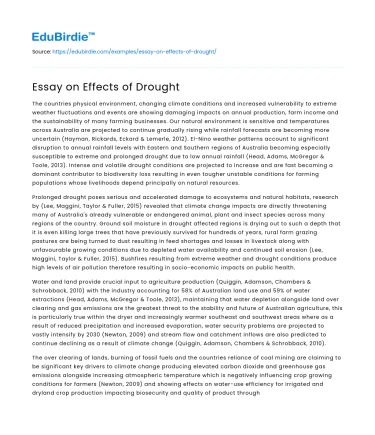The countries physical environment, changing climate conditions and increased vulnerability to extreme weather fluctuations and events are showing damaging impacts on annual production, farm income and the sustainability of many farming businesses. Our natural environment is sensitive and temperatures across Australia are projected to continue gradually rising while rainfall forecasts are becoming more uncertain (Hayman, Rickards, Eckard & Lemerle, 2012). El-Nino weather patterns account to significant disruption to annual rainfall levels with Eastern and Southern regions of Australia becoming especially susceptible to extreme and prolonged drought due to low annual rainfall (Head, Adams, McGregor & Toole, 2013). Intense and volatile drought conditions are projected to increase and are fast becoming a dominant contributor to biodiversity loss resulting in even tougher unstable conditions for farming populations whose livelihoods depend principally on natural resources.
Prolonged drought poses serious and accelerated damage to ecosystems and natural habitats, research by (Lee, Maggini, Taylor & Fuller, 2015) revealed that climate change impacts are directly threatening many of Australia's already vulnerable or endangered animal, plant and insect species across many regions of the country. Ground soil moisture in drought affected regions is drying out to such a depth that it is even killing large trees that have previously survived for hundreds of years, rural farm grazing pastures are being turned to dust resulting in feed shortages and losses in livestock along with unfavourable growing conditions due to depleted water availability and continued soil erosion (Lee, Maggini, Taylor & Fuller, 2015). Bushfires resulting from extreme weather and drought conditions produce high levels of air pollution therefore resulting in socio-economic impacts on public health.
Save your time!
We can take care of your essay
- Proper editing and formatting
- Free revision, title page, and bibliography
- Flexible prices and money-back guarantee
Water and land provide crucial input to agriculture production (Quiggin, Adamson, Chambers & Schrobback, 2010) with the industry accounting for 58% of Australian land use and 59% of water extractions (Head, Adams, McGregor & Toole, 2013), maintaining that water depletion alongside land over clearing and gas emissions are the greatest threat to the stability and future of Australian agriculture, this is particularly true within the dryer and increasingly warmer southeast and southwest areas where as a result of reduced precipitation and increased evaporation, water security problems are projected to vastly intensify by 2030 (Newton, 2009) and stream flow and catchment inflows are also predicted to continue declining as a result of climate change (Quiggin, Adamson, Chambers & Schrobback, 2010).
The over clearing of lands, burning of fossil fuels and the countries reliance of coal mining are claiming to be significant key drivers to climate change producing elevated carbon dioxide and greenhouse gas emissions alongside increasing atmospheric temperature which is negatively influencing crop growing conditions for farmers (Newton, 2009) and showing effects on water-use efficiency for irrigated and dryland crop production impacting biosecurity and quality of product through regionally introduced pests and diseases (Chapman, Chakraborty, Dreccer & Howden, 2012).
The idea of carbon farming seems to have been well received but slowly adopted by Australian farmers over recent years although has been proven to improve soil quality and reduce greenhouse gas emissions aiming to boost long term farm productivity and profitability. Flexible and robust planning and management alongside swift targeted action towards adaption and mitigation to rehabilitate dry, degraded and salt ravaged landscapes needs to be prioritised to restore farmers faith and control further ecological damage (Hayman, Rickards, Eckard & Lemerle, 2012).






 Stuck on your essay?
Stuck on your essay?

